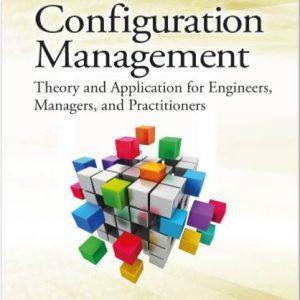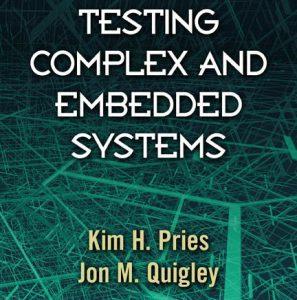Configuration Management and Testing and Verification
Configuration management (CM) and product testing and verification are inextricably linked processes crucial for successful product development and production. Without effective configuration management, performing effective testing becomes difficult. CM provides the foundation for efficient, reliable, and insightful testing activities in today’s complex and constantly evolving systems across automotive, aerospace, defense, and software development industries. This is particularly important for incremental product delivery and becomes increasingly crucial with the delivery of multiple components, whether hardware or software, as well as the testing of subsystems or systems of systems.
What is Configuration Management? Configuration management is a systematic approach to managing changes to a system or product throughout its lifecycle. It involves identifying, controlling, and tracking changes to product configurations. This includes establishing policies, procedures, and guidelines for managing changes, creating a configuration baseline to document the specific components and characteristics of the system, and maintaining a configuration history to track changes over time. The objective of CM is to ensure that a system or product is built and maintained according to its intended design and remains compliant with regulatory standards.
The core elements of Configuration Management (CM):
Configuration Management Plan
Defining the policies, procedures, and guidelines for managing the system’s configuration. This will guide the iterations, determine which product elements require special attention should something change, and decide how to label these identified areas. Essentially, the plan sets the operational space for this specific endeavor.
Configuration Identification
Meticulously documenting a system’s components, interfaces, and characteristics establishes a configuration baseline, a detailed record of the product’s state at a specific time.
Configuration Control
Managing changes to a system or product’s configuration, ensuring they are appropriately authorized, documented, and tested before implementation.
Configuration Status Accounting
Recording and reporting information about the established product configuration, the status of requested changes, and the implementation of approved changes.
Configuration Auditing
Systematically reviewing a system’s configuration to ensure compliance with established standards and policies and verifying that the system functions as intended.
What does this do for success?
Overall, configuration management ensures the product increments are known, and we can fall back to a previously known iteration of the product if the last release is defective. Known increments enable planning for test equipment, tools, and test data before the increment’s delivery, facilitating adequate test preparation. This assures us that the test folks are unsurprised by what is in this product increment.
Configuration management also ensures that all constituent parts of the system can fit and work together to achieve the system’s objectives. From experience, when done poorly, our test engineers often test systems that were designed to work together on paper but are not built according to the design, and therefore do not function as intended. This results in extra work for the test engineers to identify the failure and articulate it in the defect report. This adds to the product cost, stresses the team members, and risks the launch date.
Why is CM Crucial for Testing and Verification?
Configuration management directly supports and enhances testing and verification activities in several critical ways. As we articulated above, configuration management is there to control the product iterations to the degree that we can convey the specific contents of the product (hardware and software) and ensure this p
CM Plan Testing Implications
Within CM, planning involves determining the scope, schedule, resources, environments, and procedures necessary to manage configuration items (CIs). This control ensures that what is delivered to testing is either consistent or unknown. From experience, lacking this capability has a significant impact on testing.
With well-defined configuration baselines (product growth plans), testers can understand the state of the product or system at any point in the product lifecycle. This understanding is crucial for developing test plans, designing test fixtures, and crafting test cases before the product version becomes available for testing. By coupling testing plans to configuration management, teams can anticipate potential issues and prepare for testing iterations of the product more efficiently. CM also supports product change management, which is vital for testers to understand the product’s contents and make rational decisions about what is available for testing.
CI Testing Implications
Documenting the system’s components, interfaces, and characteristics focuses the testers on key product attributes. This detailed documentation serves as a blueprint for testers, enabling them to understand the system’s architecture and make informed decisions about testing strategies. Testers can create more accurate and effective test cases when they know precisely what hardware and software versions are present. Conversely, a lack of configuration management can lead to wasteful testing of features not even present in the product, consuming valuable time and resources. A part of CI is responsible for issuing release notes with each iteration of the product’s hardware or software. These notes provide an accounting of the elements in each product iteration, focusing the testing on what is available for testing, rather than relying on word of mouth.
Release Notes:
Clear and comprehensive release notes documenting all system changes are essential for testers. These notes provide context for test results, enabling testers to understand the reasoning behind modifications and facilitating better test case design and execution. Release notes are typically linked to hardware configurations by part number, content, and known bugs, and to software by part number, revision levels, software modules, functions/features, and known bugs discovered during development.
Deviation Management:
Deviations from approved configuration baselines must be carefully managed and documented. Testers must be aware of any deviations to avoid testing features that may be temporarily altered or unavailable. This can lead to testing features not truly present in the product, wasting time and resources.
- Nonconformance/Non-conformity: This is the failure to meet specified requirements for a product, service, or process. Nonconformances are typically categorized as:
- Major Nonconformance: Serious failures likely to impact product or process quality, safety, or compliance, requiring immediate corrective action.
- Minor Nonconformance: Less serious issues that do not have a significant effect and are relatively easy to correct.
Control Testing Implications
Configuration control ensures that all changes to a system are properly authorized, documented, approved, and managed before testing begins. I hope we understand that all development projects will be hit with changes as we learn and deliver iterations to testing and the customer. These must be adjudicated and coordinated with other system components to ensure the system’s viability. For example, if we change an attribute in our part of the system and do not account for that change in another part, the system may not function properly. This will disrupt the testing activities. This process is essential for minimizing the risk of introducing defects or issues to the product. By tracking the system’s evolution, testers gain insight into the potential impact of changes and can adjust their testing efforts (test case, test data, test fixture) accordingly. Without robust configuration control, unauthorized changes can easily slip into the system, leading to unpredictable test results and potential issues later in the product lifecycle.
Configuration control ensures changes to configuration items are systematically assessed, approved, and managed. Testing plays a crucial role by verifying that implemented changes maintain or enhance system quality. Controlled changes enable testing teams to anticipate potential impacts and update test cases, accordingly, maintaining traceability and consistency.
Status Testing Implications
Configuration status accounting records and reports the status of configuration items throughout their lifecycle. Testing depends on accurate and up-to-date status reports to understand current versions, change histories, defect reports, and quality outcomes. This visibility allows testing teams to target their efforts accurately, avoid redundant tests, and identify potential issues promptly.
Audit Testing Implications
Testing contributes significantly to configuration auditing by providing evidence of compliance, identifying discrepancies between documented configurations and actual implementations, and validating overall system integrity. Auditing leverages testing results to ensure accuracy, completeness, and adherence to specified standards.
Facilitating Traceability and Repeatability
Configuration management ensures traceability from requirements to specific product versions, to test artifacts (e.g., test data, test cases), and even test results. This traceability is crucial for analyzing test results, identifying the root cause of failures, enhancing testing processes, and evaluating test coverage. Configuration management also supports repeatable testing by providing a controlled environment in which testers can recreate specific system configurations, resulting in consistent and reliable results.
Avoiding Costly Mistakes
When configuration management is absent or poorly implemented, organizations risk releasing products with unknown configurations. This can lead to serious consequences, such as shipping the wrong product or fixing the wrong software version, damaging customer relationships, and significant financial losses. Effective CM also helps to reduce erroneous fault reports. It prevents testing features from being present in the product, wasting time and resources.
Integration of CM with Product Development and Testing Lifecycle
Configuration management is a fundamental process that permeates the entire product development lifecycle, influencing testing at every stage. Testing, in turn, should be continuously integrated into the development effort from the earliest stages, rather than being a last-minute activity, to allow for timely corrective actions and feedback.
Product development involves distinct segments, including product design, process design, product verification, process verification, and production. CM supports both verification and validation:
- Verification confirms whether the product meets specified requirements and specifications (“Did we build the thing correctly?”). It demonstrates that work packages conform to requirements or specifications and include testing, analysis, inspection, demonstrations, and simulations.
- Validation assesses whether the product meets the customer’s actual needs and expectations (“did we build the correct thing?”). In validation, special attention is paid to how the end customer will use the product.
CM plays a crucial role in managing the use of prototypes and simulations. Prototypes serve as models for learning, testing, and refining design. Simulation, often referred to as virtual testing, enables the cost-effective evaluation of various scenarios and configurations early in the development process. In our view, simulations should be coupled with actual engineering testing to ensure the fidelity of the correlation between the model and the actual world. In this way, CM ensures the accuracy and configuration tracking of these models and simulations, thereby improving their predictive capabilities.
CM manages the feedback loop from testing outcomes, which are analyzed to adjust the product or process. This continuous improvement cycle is essential for product maturity. CM activities also adapt across the various phases of the product lifecycle, including development, introduction, growth, maturity, and decline.
Configuration management and testing are inextricably linked. Effective configuration management provides the foundational structure for efficient, reliable, and insightful testing processes, especially as technical products become increasingly complex and interconnected. CM ensures that testing efforts are focused, accurate, and valuable by meticulously documenting system compositions, controlling changes, enabling precise test planning, facilitating traceability and repeatability, and actively managing deviations. Embracing robust CM practices allows organizations to ensure the quality and reliability of their products, minimize risks, and ultimately deliver superior customer experiences.
For more information, contact us:
The Value Transformation LLC store.
Follow us on social media at:
Amazon Author Central https://www.amazon.com/-/e/B002A56N5E
Follow us on LinkedIn: https://www.linkedin.com/in/jonmquigley/
https://www.linkedin.com/company/value-transformation-llc
Follow us on Google Scholar: https://scholar.google.com/citations?user=dAApL1kAAAAJ






